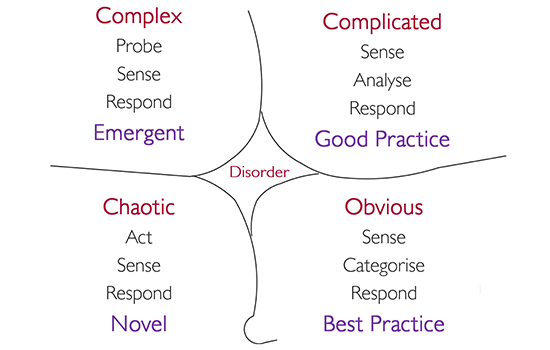As we emerge from the chaos of the pandemic let’s focus on where we want to go, but remember there’s no single way to get there, says David Reece.

Mufaddalap from Pixabay
The current pandemic has caused widespread disruption and forced upon us all a new way of living, turning our worlds upside down almost overnight. Where do we go from here when there is no obvious answer, only a lot of possible options? There will be many roads to recovery, but if we follow some guiding principles we can make sure we’re heading in the right direction.
A Cynefin framework, developed by IBM as a decision-making framework to deal with real-world problems of varying complexity, can help. The key is to diagnose a situation in one for four ways, rather than falling into a vortex where disorder reigns. These situations range from the Obvious, where we can rely on best practice to come up with a solution, all the way round to the Chaotic, which requires novel solutions.

From the Chaotic to the Complex
The shutdown of our industry was chaotic. We had to act. There was no time to consult, but as we emerge from the Chaotic and enter the Complex there are still no clear answers so we must use what we have to guide us, armed with all the skills, the creativity, the passion and determination which make our industry so great.
Hard choices have already been made and more hard choices are ahead of us, but this is an opportunity to look at things differently, to assess what is and isn’t working within your organisation and begin to make the necessary changes on the road to recovery.
To prepare ourselves for the road ahead, we should probe the past, sense the present and respond accordingly as we plan for the future.
Probe the past
Confucius was right: “Study the past if you would divine the future".
The audience of the past is still the audience of the future in one form or another. So even in these times an understanding of past trends will provide an invaluable evidence-base to aid decision making and help you concentrate limited resources on areas of the greatest impact to your bottom line. By establishing historical demand patterns across a ‘normal’ timeframe you create a base line as a point of comparison going forwards, helping you set focused objectives.
Analysis will also expose any vulnerabilities in the short-term if re-opening means a reduction in capacity or reconfiguration of what’s on offer. For example, a visitor attraction might not be able to achieve peak capacity during school holidays if it is not safe to do so, so instead will need to maximise income from a smaller number people wanting to visit on those peak days by making admission pricing, donations, and secondary spend work harder.
An understanding of your audience will also inform your plans for re-opening and how you re-engage with them in future. Performing arts venues that rely on senior audiences for weekday matinees might need to rethink what they programme on these days if that audience is less likely to return in the short-term. If you normally attract customers from a wide market, how much potential is there within the local market instead? How big is your core audience - those regular, repeat customers who account for a disproportionate number of tickets and income? These are likely to be among the first to return, and some will have continued to buy tickets for the future, but how much harder can you work this core? How frequently can they be expected to visit? More than before? And importantly, how much are they willing to pay? How should you adapt your offer and your communications to engage with these key customers?
To address some of these questions, we must turn to the present.
Sense the present
Given the uncertainty across the globe right now, it’s not surprising that research about how customers feel about returning to cultural attractions is one of hesitancy with concerns around safety. Then again, what people say they are concerned about in a survey and what they actually do in reality don’t always align as recent trends in increased footfall in parks, transit hubs and workplaces have begun to reveal. That’s not to say that we should ignore these concerns, and venues should certainly be looking to create safe spaces, but it’s important to understand the limitations of any research and how it applies to your own situation.
If you are going to survey your audience, first ask yourself ‘what I am going to do with this information’? It might not cost much money to send out multiple surveys, but it does cost a lot of time and goodwill both on behalf of the respondent and when analysing the results, so survey wisely. Ensure the results from your survey sample are proportionally representative of your target audience – which means going back to your data – and be aware of framing questions in a way that leads to response bias. For example, providing a set of predetermined response options might make people think about something in a way they had not really considered before, and thus inadvertently influence their decision.
Questions relating to price are particularly challenging to research effectively. The price someone is willing to pay depends on the value they think they are getting in return – and this will be different for each person. So be specific: find out how much more, and for what extra value, as well as what they were previously paying in the past. Simply asking what people would be willing to pay will skew the results. Asking them to make choices between different options in a series of scenarios will result in a much better understanding of what people value and how much they would pay for it.
Armed with a detailed understanding of historical demand, past customer behaviour and insights into the current state of potential customers, we can now use this information to respond and plan for a successful reopening.
Respond
“The best way to predict the future is to create it” said Abraham Lincoln (perhaps).
While your overall objectives and aims as an organisation might not have changed, your strategy for achieving them, at least in the short-term, undoubtedly needs to adapt. Dedicating sufficient resources to planning is crucial. It is better to have adaptive, analytical people exploring potential options for what you can do tomorrow than creating lots of free digital content for today.
Rather than indiscriminate discounting, any immediate changes required for re-opening should be implemented so as to not undermine your longer-term objectives. For example, you might offer temporary memberships which expire after 6 months or a different range of prices to reflect your reconfigured offer. Remember there is no such thing as best practice in the Complex realm. This is the time to look for alternative solutions, novel ideas and experiment. Think drive-in opera or art experiences, digital concert halls, social distance bracelets. Be creative, and share your experiences.
Finally, as venues and attractions do begin to open their doors, it’s important to have in place indicators to monitor and track your recovery. How quickly are audiences returning? How frequently? How much are they spending? Be aware of wider trends across the industry, but be wary of benchmarking against others. Your situation is unique and what works for someone else won’t necessarily work for you. There are many roads to recovery, and just because you start on one doesn’t mean that’s the one you should stay on.
David Reece is Deputy Chief Executive at Baker Richards.
www.baker-richards.com
This article, sponsored and contributed by Baker Richards, is part of a series sharing insights into how organisations in the arts and cultural sector can achieve their commercial potential.





